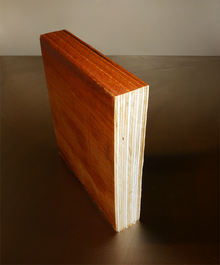Laminated veneer lumber
A laminated veneer lumber ( FSH ; also LVL derived from English laminated veneer lumber ) is a wood material , which in the timber is used and the wood aircraft. The laminated veneer lumber consists of approx. 3 mm thick peeled veneers made from softwood (rarely also from hardwood ). It is used for the production of panels and panes (flat surface structures ) and instead of solid wood - beams in the form of beams , wooden double-T beams and supports . The veneer layers are usually bonded with phenolic resin . The heavy-duty "technical beech plywood" TBu-20 with 20 layers of veneer per centimeter of thickness was produced for aircraft construction.
In contrast to veneer plywood , the veneer layers are not alternately glued crosswise, but predominantly parallel to the grain, so that material properties such as strength values are strongly direction-dependent.
Dimensions
Veneers all oriented lengthways (carrier)
- 75 mm ≤ thickness ≤ 200 mm
- 21 mm ≤ width ≤ 75 mm
- Length ≤ 23,000 mm
Veneers lengthways with additional barrier layers (panels)
- 21 mm ≤ thickness ≤ 69 mm
- Width ≤ 2500 mm
- Length ≤ 23,000 mm
Plate types
| designation | scope of application | Use class and hazard class |
|---|---|---|
| LVL / 1 | Use in dry areas | 1 |
| LVL / 2 | Use in damp areas | 1 and 2 |
| LVL / 3 | Use outdoors | 1 to 3 |
Areas of application
The laminated veneer lumber must be suitable for the climatic conditions in the respective area of application. The assignment of the usage classes correlates with the area of application. In connection with the usage classes, the hazard classes must be observed.
For use in service class 3, treatment with a wood preservative approved by the building authorities is required. Use in common rooms (usage class 1) should then be avoided due to the wood preservative used.
Technical and building physics parameters
| property | unit | Parameter |
|---|---|---|
| Bulk density | kg / m³ | 480 to 580 |
| Calculation weight | kN / m³ | 4.5 to 5.5 |
| Moisture content | % | 6 to 12 |
| Shrinkage / swelling | ||
| - Veneers all oriented lengthways | % | along 0.01; across 0.32 |
| - Veneers lengthways with additional barrier layers | % | along 0.01; across 0.03 |
| Dimensional tolerances for limit dimensions | see plywood | |
| Water vapor diffusion resistance number | - | wet = 50; dry = 400 |
| Thermal conductivity | W / (m K) | 0.15 |
| Fire behavior class | D-s2, d0 |
Labelling
The following information must be attached to the product , delivery note or accompanying paper :
- Name or abbreviation of the manufacturer
- Standard: DIN EN 14279
- Type designation (for example LVL / 3)
- Nominal thickness in mm
- Main axis
- Formaldehyde release class
General building approval
The laminated veneer lumber must be marked with the conformity mark ( CE mark ) since April 1st, 2004 . A distinction is made in the labeling between structural and non-structural use.
In addition to the CE mark, laminated veneer lumber can also be marked with a general type approval.
Timber construction
The use of laminated veneer lumber requires proof of usability by means of general type approval. In the approval, the panel structure, the veneer thickness, as well as the characteristic strength, rigidity and bulk density values must be specified. When used in timber construction (according to DIN 1052), DIN V 20000-1 must be observed.
In addition to being used as a beam or pane, laminated veneer lumber is suitable as a beam reinforcement in the support area when renovating beams.
Transport and Storage
It must be ensured that the panel moisture does not increase in an impermissible manner, for example through precipitation or soil moisture . Proper covered storage is imperative.
swell
- ↑ Mechanical parameters of beech, ash and robinia wood for load-bearing components , p. 4, dissertation by Ulrich Hübner, Graz University of Technology
- ↑ DIN prEN 14279
- ↑ DIN EN 335-3
- ↑ DIN 1055-1
- ↑ DIN prEN 14273
- ↑ DIN EN 315
- ↑ DIN EN 13986
- ↑ DIN EN 13986
- ↑ DIN prEN 14279
- DIN 1052 (timber construction)
